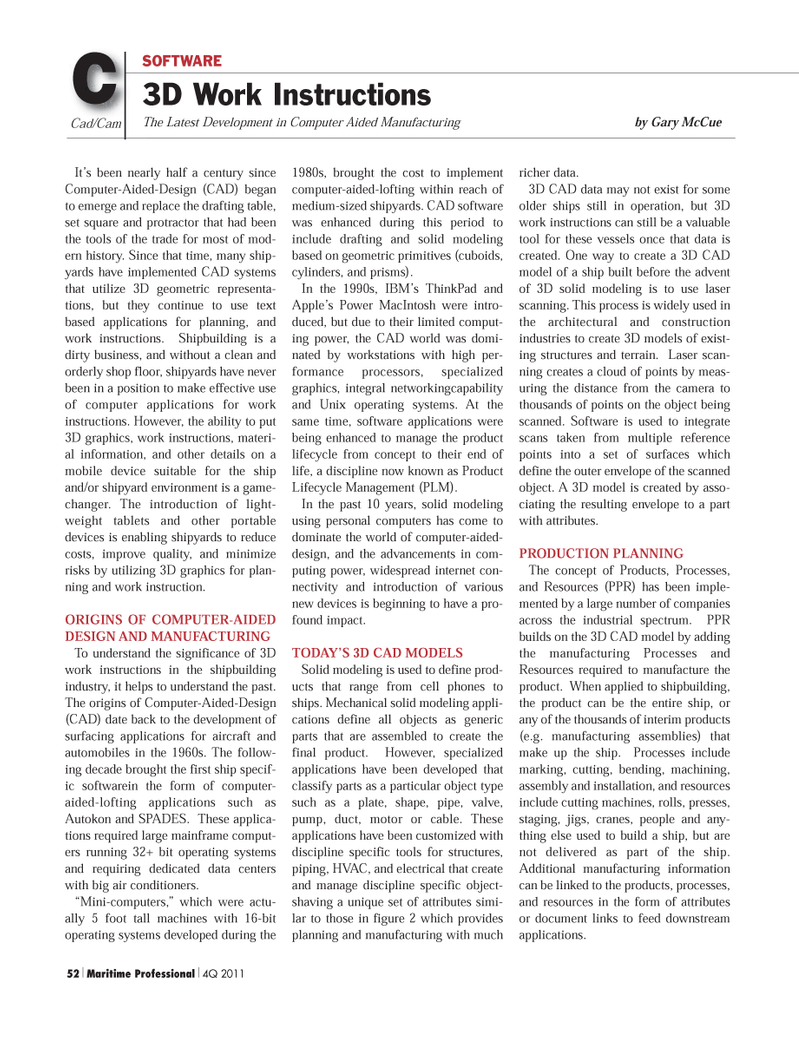
Page 52: of Maritime Logistics Professional Magazine (Q4 2011)
Classification
Read this page in Pdf, Flash or Html5 edition of Q4 2011 Maritime Logistics Professional Magazine
It?s been nearly half a century since Computer-Aided-Design (CAD) began to emerge and replace the drafting table, set square and protractor that had beenthe tools of the trade for most of mod-ern history. Since that time, many ship- yards have implemented CAD systems that utilize 3D geometric representa-tions, but they continue to use text based applications for planning, andwork instructions. Shipbuilding is a dirty business, and without a clean and orderly shop floor, shipyards have never been in a position to make effective use of computer applications for work instructions. However, the ability to put 3D graphics, work instructions, materi- al information, and other details on amobile device suitable for the ship and/or shipyard environment is a game- changer. The introduction of light- weight tablets and other portabledevices is enabling shipyards to reduce costs, improve quality, and minimize risks by utilizing 3D graphics for plan-ning and work instruction. ORIGINS OF COMPUTER-AIDEDDESIGN AND MANUFACTURING To understand the significance of 3D work instructions in the shipbuilding industry, it helps to understand the past. The origins of Computer-Aided-Design (CAD) date back to the development of surfacing applications for aircraft and automobiles in the 1960s. The follow- ing decade brought the first ship specif- ic softwarein the form of computer- aided-lofting applications such asAutokon and SPADES. These applica- tions required large mainframe comput- ers running 32+ bit operating systemsand requiring dedicated data centerswith big air conditioners.?Mini-computers,? which were actu- ally 5 foot tall machines with 16-bitoperating systems developed during the 1980s, brought the cost to implementcomputer-aided-lofting within reach of medium-sized shipyards. CAD software was enhanced during this period to include drafting and solid modelingbased on geometric primitives (cuboids, cylinders, and prisms). In the 1990s, IBM?s ThinkPad and Apple?s Power MacIntosh were intro- duced, but due to their limited comput- ing power, the CAD world was domi- nated by workstations with high per- formance processors, specializedgraphics, integral networkingcapability and Unix operating systems. At the same time, software applications were being enhanced to manage the productlifecycle from concept to their end of life, a discipline now known as Product Lifecycle Management (PLM). In the past 10 years, solid modelingusing personal computers has come todominate the world of computer-aided- design, and the advancements in com- puting power, widespread internet con- nectivity and introduction of various new devices is beginning to have a pro- found impact.TODAY?S 3D CAD MODELS Solid modeling is used to define prod- ucts that range from cell phones toships. Mechanical solid modeling appli-cations define all objects as genericparts that are assembled to create thefinal product. However, specialized applications have been developed that classify parts as a particular object typesuch as a plate, shape, pipe, valve, pump, duct, motor or cable. These applications have been customized with discipline specific tools for structures, piping, HVAC, and electrical that create and manage discipline specific object- shaving a unique set of attributes simi- lar to those in figure 2 which provides planning and manufacturing with much richer data.3D CAD data may not exist for some older ships still in operation, but 3D work instructions can still be a valuable tool for these vessels once that data is created. One way to create a 3D CAD model of a ship built before the advent of 3D solid modeling is to use laserscanning. This process is widely used in the architectural and constructionindustries to create 3D models of exist- ing structures and terrain. Laser scan-ning creates a cloud of points by meas-uring the distance from the camera tothousands of points on the object beingscanned. Software is used to integrate scans taken from multiple reference points into a set of surfaces which define the outer envelope of the scanned object. A 3D model is created by asso- ciating the resulting envelope to a part with attributes. PRODUCTION PLANNING The concept of Products, Processes,and Resources (PPR) has been imple-mented by a large number of companiesacross the industrial spectrum. PPRbuilds on the 3D CAD model by adding the manufacturing Processes and Resources required to manufacture the product. When applied to shipbuilding, the product can be the entire ship, orany of the thousands of interim products (e.g. manufacturing assemblies) that make up the ship. Processes include marking, cutting, bending, machining,assembly and installation, and resourcesinclude cutting machines, rolls, presses,staging, jigs, cranes, people and any- thing else used to build a ship, but are not delivered as part of the ship. Additional manufacturing information can be linked to the products, processes, and resources in the form of attributes or document links to feed downstream applications.52 Maritime Professional 4Q 2011CCad/Cam3D Work Instructions The Latest Development in Computer Aided Manufacturing by Gary McCueSOFTWARE MP #4 (50-64):MP Layouts 11/8/2011 2:29 PM Page 52

 51
51

 53
53
